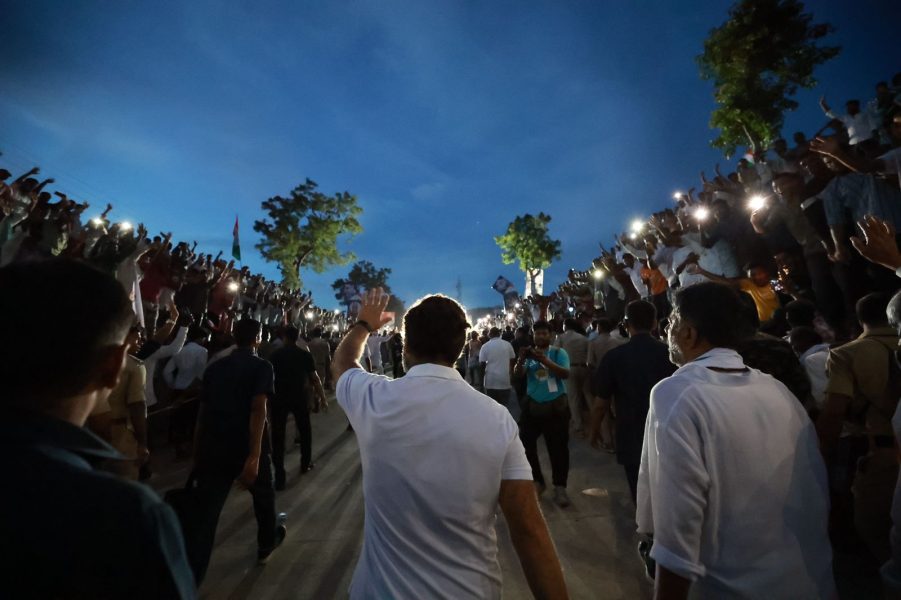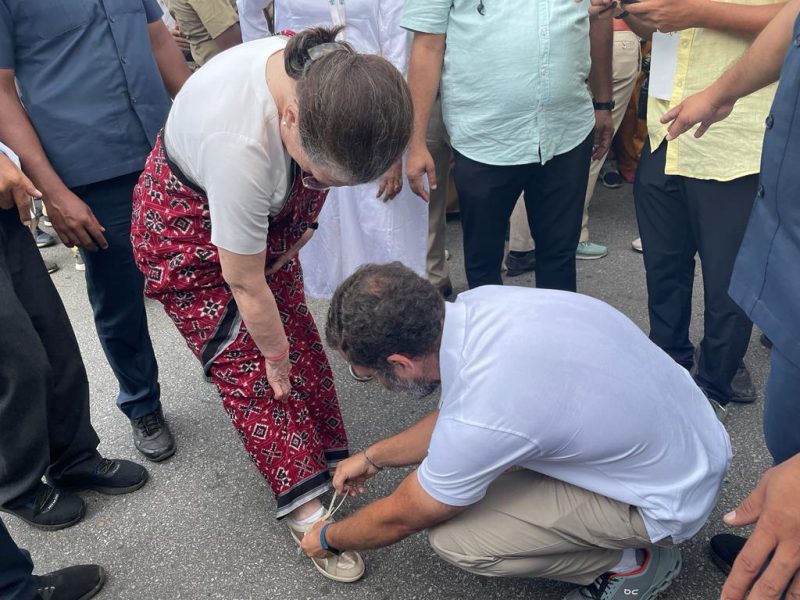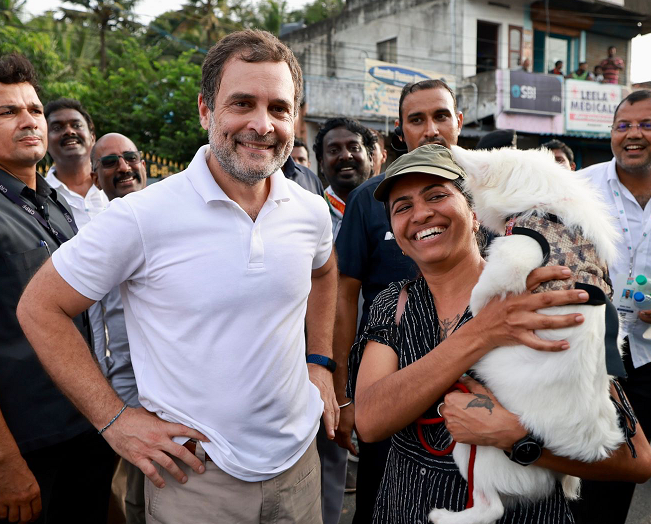
Bharat Jodo Yatra: Key to Congress’ electoral revival lies elsewhere
While the padyatra may give Rahul an image makeover, the real test of its success in reviving the party’s electoral fortunes lies in 2024

It has been a little over a month since Rahul Gandhi embarked on his 3,570 km-long Bharat Jodo Yatra (BJY) from Kanyakumari. That the past 35-odd days of the walkathon have proved to be a major morale booster for the Congress party, which has been grappling with a deepening existential crisis since 2014, is evident from the powerful images that have come out from the Yatra almost every single day.
Beyond the expected participation of Congress leaders from Tamil Nadu, Kerala and Karnataka, states that Rahul and his co-travellers have traversed through or are currently walking across, the BJY has drawn massive crowds from the common citizenry.
Explainer: 10 things about Congress’ massive foot march, Bharat Jodo Yatra
Old and young, men and women, able-bodied as well as persons with disabilities, distressed farmers, victims of government apathy during the COVID pandemic, academics, activists, civil society representatives, and Rahul, have all walked miles, embodying the yatra’s slogan — Mile Kadam, Jude Watan (we march as one country).
Moments to remember
The Yatra’s organisers and the Congress party’s communication department have also worked round-the-clock to project at least one potent moment each day of the walkathon — be it that of a drenched Wayanad MP addressing a packed gathering in Mysore despite a heavy downpour or that of Rahul tying the shoelaces of his mother, interim Congress chief Sonia Gandhi, who had joined the Yatra briefly in Mandya. There have been light-hearted moments of Rahul sprinting with Siddaramaiah and DK Shivakumar and there have been tear-jerkers such as the interaction Rahul had with people who had lost dear ones to COVID.
Also read: Bharat Jodo Yatra: Rahul pledges to ‘unite India’ in tribute to Gandhiji
And then there have been countless occasions reminiscent of the adulation that Rahul’s father, the late Rajiv Gandhi, would draw from common people back in the early 1980s during his public outings. The elderly, the poor and the destitute, adults, kids from colleges or even those in school have all thronged to the Yatra, rushed past Rahul’s security detail only to walk a few steps shoulder-to-shoulder with the Nehru-Gandhi scion — just as they did when Rajiv first came on the country political horizon or even when Sonia took her first steps into politics back in the late 1990s touring the length and breadth of the country to conduct her famous and hugely popular road shows.

Scripting a makeover?
All of this for a leader written off, lampooned and criticised repeatedly, for Rahul, during his stint as Congress president and, over the past three years, as a leader who enjoys tremendous power over his party with zero accountability, has presided over and contributed to a worsening atrophy of the Grand Old Party (GOP). Rahul has often been accused, arguably with good reason, of being inaccessible, of prioritising his foreign jaunts over crucial organisational matters and of being a non-serious politician who picks up the right causes occasionally but abandons them mid-way.
But now, as the mascot of the Bharat Jodo Yatra, the biggest public outreach programme of the Congress since Rajiv’s Bharat Yatra of 1990, Rahul seems to be scripting a makeover of his public persona. A prominent columnist and political commentator, who has also been a trenchant Rahul-critic, remarked recently: “Finally, this is a Rahul Gandhi India can relate to”.
Analysis: As Rahul’s Bharat Jodo Yatra assumes pilgrimage’s hue, BJP tries to cover tracks
The BJY has showcased a Rahul who revels in the company of the common folk, who is empathetic to their problems, listens patiently to their grievances and one who is stridently opposed to the politics of hate and division; be it communal, social, regional or linguistic. He speaks for the oppressed — be it women, Dalits, tribals or backward communities — while emphasising that if India were to truly progress, it would only do so if its people remained united and not torn apart by hate, bigotry and inequality.
Much of this has been said by Rahul in the past, too. The difference now is that it’s happening not from the podium of an election rally or the restricted precincts of Parliament or in the virtual world of Twitter and Facebook, but in a cross-country padyatra that gives Rahul the advantage of physical proximity to the public every single day. Whether this would influence the electoral outcome of the 2024 Lok Sabha polls in the Congress’s favour will, however, depend on a multitude of factors, including Rahul’s own consistency and commitment towards staying on his current course as well as the GOP’s ability to complement Rahul’s newfound popularity with an appetite for leading a spirited and cohesive political fight against the BJP.
Also read: Rahul strives for DKS, Siddaramaiah unity; knows its crucial for Cong in Karnataka
Road to penance
By Rahul’s own admission, the BJY has allowed him to present to the people “my truth”. During his interaction with the media in Karnataka’s Turuvekere on October 8, Rahul was asked to share his experience, personal not political, of participating in the yatra. His response, though a tad muddled, unnecessarily long-winded and somewhat sanctimonious, perhaps owing to his evident incapacity in giving politically astute and measured replies, was instructive.
“I stand, and have always stood, for certain ideas and that, of course, disturbs the BJP, disturbs the RSS and disturbs the other forces. Thousands of crores of media money, of media energy has been spent in trying to shape me in a way which is just untruthful and wrong. That machine is going to continue and that machine is very well oiled, very financially rich. My truth is different. It has always been different and the people, who care to look carefully, will see what I stand for and what my truth is,” Rahul had said.
Analysis: There is no short cut to Delhi through South India
He explained that the “main purpose” of the BJY was to bridge the “distance that has developed between the political class and our citizens”. Rahul likened his participation in the padyatra to his tapasya (penance) and asserted that he had wanted for himself “an element of suffering”. This suffering, Rahul said he believed, would come from walking the entire stretch of the 3,570-km BJY route so that he could meet and interact with people from all walks of life and from different parts of the country.
Rahul’s response is indicative of a leader who wants to mingle with the hoi polloi not just when elections are round the corner. This may not absolve him of the criticism of being inaccessible to his own party colleagues. Yet, it certainly shows him in better light compared to his political rivals or even compatriots when judged in the court of the people.
Beginning of the revival?
Jairam Ramesh, chief of the Congress’s communication department, believes the BJY has allowed not a new but “the real Rahul Gandhi” to emerge as opposed to the one trapped in the image created by the BJP’s “malicious propaganda”. Obviously, the party is also hoping that this “transformation” would help it electorally. Ramesh makes it amply clear that the yatra isn’t merely a social movement, but also a political one.
The BJY still has at least another four months to go before it concludes in Kashmir’s Srinagar sometime in early March 2023. The Congress would get a new and non-Gandhi president next week. The 80-year-old Mallikarjun Kharge is widely tipped to win the contest against Shashi Tharoor. It is not yet clear what role the new Congress chief would have in the BJY but suffice to say it would be Rahul who would remain the face of the yatra. As such, while the new Congress president will be required to address organisational issues — under the obvious guidance of the Gandhi family — the task of public mobilisation for the party will remain with Rahul.

Before the BJY concludes, elections will be held for the assemblies of Gujarat and Himachal Pradesh — both states not included in the Yatra’s route despite the Congress facing an uphill electoral battle against the presently ruling BJP and an expansionist AAP. Rahul, party insiders say, will take a break from the BJY to “address a few rallies” in the two states but his involvement in the campaign is unlikely to be as extensive as it was in the elections for these states, particularly Gujarat, back in 2017. In the event of electoral setbacks in one or both the states, the party, sources say, will try to de-link Rahul and the yatra from the poll results though the BJP and the AAP are unlikely to make doing so an easy task.
Electoral harvest
The real test of how successful Rahul has been in scripting a Congress revival through the yatra will, thus, be the 2024 Lok Sabha polls, which will take place a full year after the BJY concludes. For Rahul and the Congress to reap any electoral benefit from the current euphoria over the yatra, the momentum gained thus far will need to be kept up for a whole year after the BJY ends.
Also read: Bharat Jodo Yatra: Sonia joins Rahul in Mandya; ‘her era will start again’, says DKS
This is no easy ask from a party prone to inertia, unremitting internal squabbles, inconsistent voter engagement and shoddy electoral planning. There are already concerns being raised within the party that local units in Tamil Nadu and Kerala were doing precious little to keep alive the euphoria triggered in the Congress’s favour when the BJY was passing through these states. Party insiders express similar fears over the possibility of the Congress sinking back into its typical factional feuds in Karnataka, particularly between the camps of Siddaramaiah and DK Shivakumar, once the BJY moves out of the state.
A senior party leader remarked, “Rahul ne sama toh baandh diya hai lekin isse banaye rakhna pradesh ke netaon ki zimmedari hai (Rahul has created a positive environment for the party but sustaining it will be the responsibility of the state leadership).”
A section of Congress leaders also believes that the yatra’s electoral benefits can only be reaped if the party simultaneously works on other organisational deficiencies. “It would be wrong to assume that just because the yatra is drawing huge crowds and Rahul is getting good press, we are on the path to revival. Crowds can never be an accurate barometer of voter sentiment and we have seen this in election after election. We got huge participation in Tamil Nadu but it is a state where we are a marginal player and there are other states which are not even part of the yatra’s route — states like Bihar, Orissa, Bengal or even UP where the yatra will pass through but only for very few days, where our organisation is practically non-existent… the yatra may improve the morale of party workers but it won’t automatically rebuild the organisation and without a strong organisation, we can’t hope for an electoral revival,” a veteran Congress MP told The Federal.
The BJY may, thus, give Rahul an image makeover and this may prove beneficial for him in the long run, provided he continues to aggressively engage with the people and doesn’t squander away his new-found goodwill by slipping back into the mould of a transient politician. However, the glide path for an electoral makeover for the Congress may not lie on the route of the Bharat Jodo Yatra alone. Rahul and his Congress may yet need to seek that path elsewhere.


